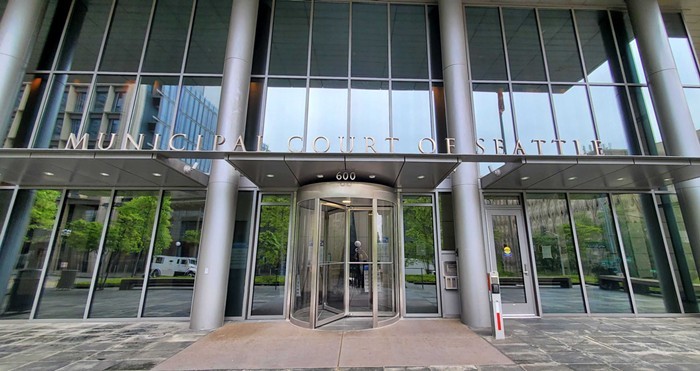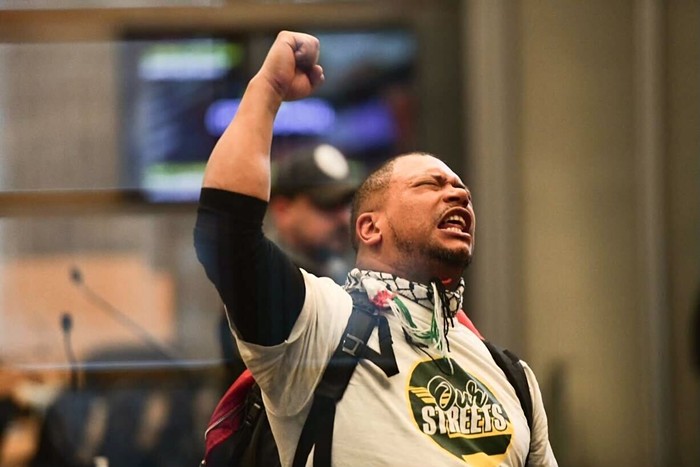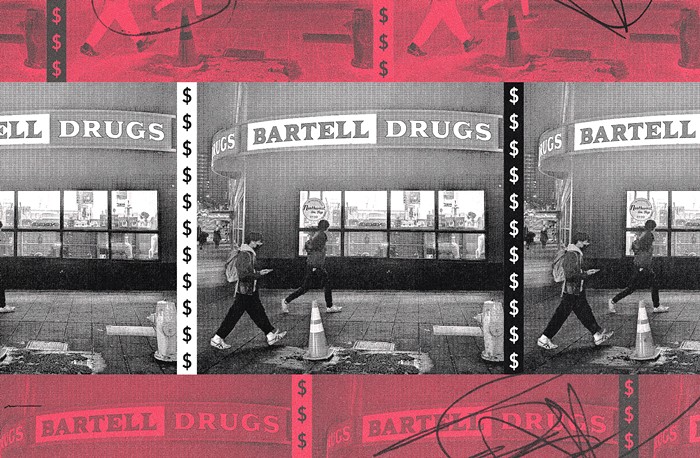When war actually started on March 19, however, antiwar activists' plans failed miserably. While activists had managed to pull around 20,000 people downtown for a preemptive antiwar protest in February, the largest crowd they could muster once war began was 3,000 people. And those who showed up seemed content to chant, wave at cars, and walk in circles from the Federal Building to Westlake Center and back.
Meanwhile, amped crowds took over streets and bridges in cities like San Francisco (where 1,400 people got arrested after protesters shut down the city's financial district), Portland (where defiant protesters shut down freeways and drew pepper spray from cops), Chicago (where more than 10,000 people marched, shutting down Lake Shore Drive), and New York City (where over 100,000 protesters shut down Broadway from Herald Square to Washington Square Park).
Seattle's opening shot against the war was orderly and drew only 2,000 to 3,000 people--barely twice the number of people who got arrested in San Francisco. Over the next few days, 43 people were arrested in Seattle--hardly a dramatic or surprising show of civil disobedience. (On March 20, as a student walkout cheerfully and obliviously passed the Chevron at Broadway and 10th Avenue, one couldn't help but think back on the Gulf War protests of '91, when the "No Blood for Oil" chants translated into gas station sit-ins.)
Seattle--infamous for its rambunctious WTO protests--didn't even warrant a mention on the national news as reporters rattled off a list of cities where people dramatically protested the war. "Everything was perfectly fine," says police spokesperson Scott Moss about the initial March 20 protests. "Nothing at all happened."
Protesters tried something on Saturday, March 22--an unauthorized downtown "snake march." But the march ended up cornered by police in Pioneer Square. At 5:45 p.m., cops threatened to arrest the few hundred protesters holding court at First Avenue and Jackson Street, and activists gave up and went home. They could have volunteered for arrest, in what would have been Seattle's largest act of antiwar civil disobedience yet. But they didn't.
By Tuesday, March 25--with U.S. ground troops just outside Baghdad--Seattle's long-planned initial burst of antiwar protests had already fizzled out. After months of buildup, the low attendance and lack of civil disobedience were incredibly disappointing.
There's hope among local activists that Seattle will soon imitate San Francisco's tactics; there, "smart mobs" of 20 people (or less) closed off one intersection, then dashed to the next location before cops could catch up. "See how S.F. did it. Small, quick groups spontaneously shut down intersections, freeway ramps, and big business," one activist chimed in during an online discussion assessing the protests and future tactics.
New York activists plan to try the San Francisco tactics on March 27. Seattle activists haven't picked a date.
Day After the War: Students Walk Out, Head to Westlake
Seattle's protests began when about 1,600 students from across the city staged a well-planned noon walkout that converged on Westlake Center at 3:00 p.m. Two student contingents--one from the University of Washington and one from Seattle Central Community College--joined forces at the I-5/Roanoke Street overpass.
As the UW group--which included North End high school students from schools like Ballard and Roosevelt--waited at the corner of Eastlake Avenue and Lynn Street, they talked excitedly about the Capitol Hill group on its way over. "There's another 1,000 or 2,000 on their way," a UW organizer told the crowd over a megaphone. "They're about 10 blocks away. We're going to wait for them here." Even the cops guarding the UW crowd had high hopes for the Capitol Hill group. "That should make a good shot for the cameras," one cop said, pointing to a corner two blocks uphill and next to the freeway, where the crowd was expected to emerge any minute.
But the Capitol Hill crowd wasn't even close to 2,000 students. It was more like 700 or 800--just slightly bigger than the UW crowd waiting on Eastlake, a group that barely filled an intersection (partly because students kept wandering to a nearby minimart to buy snacks). All together, the march could maybe fill two blocks--but only if it stretched out.
Some student organizers blamed the low attendance on timing: Finals week was wrapping up as war started, and many college students--from the UW, SCCC, and Seattle University--had already left for spring break. From the looks of the students marching, it seemed their reading was right on--most of the crowd was high-school aged. The north contingent was only half UW students.
But even the high school attendance was paltry: Of the 14,000 high school students in the Seattle public school system (and the 6,000-plus students in private Seattle high schools), only about 1,000 ditched school to protest the war.
High school students who did ditch chalked up the small crowd to teenage apathy ("A lot of kids just say 'whatever' about the war," one Center School junior said), or difficulty getting excused by their parents. "It wasn't really a walkout," says Bush eighth-grader Carl Ostergaard. He's right--a mom drove them to the UW. "And they made us bring notes."
But the small numbers didn't seem to disappoint the kids marching (nor did it undermine the obvious conviction of those who opted to walk out--like Hazel Wolf ninth-grader Kelley Winter, who approached TV cameras and demanded an interview); they were as loud as ever, getting into their antiwar chants and keeping the energy up all the way through downtown to Westlake Center.
Several Hazel Wolf students had swiped pots and pans from their school's kitchen, and used them as noisemakers. The Infernal Noise Brigade, a raucous ad hoc marching band, brought up the rear of the march .
The police, preemptively decked out in protective gear, kept an eye on the freeway adjacent to the route. The cops were ready in case this protest group tried to mimic its Bellingham counterpart--which had closed I-5 up north.
Fortunately for the cops, the students had no intention of shutting down the freeway. They did, however, inadvertently slow down traffic--police had to close exit ramps to keep cars off the marchers' route, backing up southbound I-5 to Northgate. Most drivers were good-natured about the delay, even getting out of their cars to wave at the students. (A woman driving all by herself in a four-door Volvo 240 DL honked her approval during a "No Blood for Oil" chant, apparently missing the irony.)
Finally, the students were within view of downtown, three hours after they first walked out. By 3:15 p.m., the marchers had gathered at Westlake Center and spilled out into Pine Street where a handful of protesters staged a die-in on Pine Street in front of the Westlake Starbucks--which drew plenty of gawkers and photographers.
By 4:30 p.m., there were only a few hundred people left in Westlake's plaza, and student organizers encouraged the remaining students to head toward the Federal Building at Second Avenue and Marion Street for a second march. "But stay on the sidewalk!" one organizer said. "We don't have a permit for the street!"
Spray-Paint Kids: Anarchists Steal the Show from Potlucking Peaceniks
In front of the Federal Building later that night, a small group of younger protesters tried to stir things up. After an impromptu march from Westlake (which didn't stay on the sidewalk), and an unpermitted street party on Second Avenue next to the Federal Building plaza, about two dozen masked anarchists started spray-painting antiwar messages and anarchist symbols on the street. The chemical smell of the paint drifted overhead. The police, dressed in riot gear, stood at the ready, batons drawn.
After waiting half an hour, the police wanted to clear Second Avenue and get protesters onto the Federal Building plaza--where the more mainstream, family-oriented crowd was largely ignoring the scheduled antiwar speakers in favor of watching the spray-paint kids to see what they'd do next.
A line of cops closed in from both sides. "Riot cops!" one anarchist kid yelled, pointing toward the advancing police. Then 50 kids--about half anarchists--plopped down onto the street, put on gas masks, and linked arms. Activists pledged not to budge, and said they'd sit there for "as long as it takes." Two lawyers sprang into action, giving out a legal aid phone number in case the sitters got arrested. Kids scribbled the number on their arms, and chanted "Whose streets? Our streets!" urging the several hundred people standing around them to join in.
But the moment was short-lived. The standoff was over within the hour. The police didn't advance, and didn't pull out pepper spray. Instead, they stood patiently for an hour, until the more mainstream crowd headed out on its previously scheduled loop to Westlake. Soon, only the sitters and a hundred onlookers were left at the Federal Building. "There's no reason to stay," one protester told the rest of the sitters. "Let's march!" The sitters took the suggestion, and all stood up at once to catch up with the rest of the crowd. Apparently, "as long as it takes" means "until there's something else to do."
The march circled downtown, and was back at the Federal Building by 7:30 p.m. Cops kept Second Avenue clear--irking the anarchists, who were busy figuring out what they'd do next. They didn't come up with anything, and decided to head home. Most of the crowd followed suit. While protesters in Portland and San Francisco were still in the streets, still protesting the war and shutting down their towns, Seattle retired for the night.
The Letdown: Saturday
There was still hope for action on Seattle's streets Saturday morning. After all, more people could attend on the weekend. Plus, Seattle's liveliest antiwar group, Not In Our Name (NION), was the day's sponsor. It was no secret that the group had planned a "snake march" through downtown. A snake march--unpermitted, and with no announced destination--could throw off police and snarl downtown traffic. In other words, it had the potential to shut down the town.
But that didn't happen. By 3:30 p.m., fewer than 1,000 people had gathered at the Federal Building to protest the war. (Meanwhile, over in Bellevue, 3,000 people attended a "support the troops" rally.) Undeterred, NION leaders rattled off instructions: "There is no permit for this march. Stepping into the street is an arrestable offense. Jaywalking is an arrestable offense." Activists loudly repeated the ground rules, and then swarmed into Second Avenue.
Minutes later, police pushed them back onto the sidewalks. So the unauthorized marchers headed downhill to First Avenue, and north on the sidewalk to University Street. There, the cops blocked them again; protesters switched direction and headed south. For the next hour, cops and protesters played this back-and-forth game of cat and mouse.
Finally, police cordoned off a chunk of downtown--several blocks of First Avenue, parts of Western and Second Avenues, and side streets--and wouldn't let the marchers out. Protesters angrily took over part of First Avenue in the corralled grid. Some activists got into cops' faces, while others screamed "Pigs!" and "Shame!" from the sidelines. Eighteen people were arrested, mostly on First Avenue at Spring and Marion Streets in what could hardly be described as a meaningul show of antiwar civil disobedience. While some protesters came forward at a March 25 City Council hearing with accounts of strong-arm police tactics, for the most part cops did their job when protesters took to the streets (an arrestable offense, as the protesters had been told earlier).
At about 5:00 p.m., the march--only a few hundred strong now--headed down to Pioneer Square on sidewalks, under the direction of police. At First and Jackson, police suddenly divided the crowd onto the four corners, blocked the streets, and wouldn't let the march continue (though they were happy to let people leave in small groups). Frustrated, activists sat down on the corners.
At 5:45 p.m., the cops gave an ultimatum: Activists had to leave the corner and head south in small groups, or face arrest. They had five minutes to decide.
Activists apparently didn't need five minutes. In less than two, everyone stood up and dutifully headed south to squeeze out through a cop turnstile. It seems no one saw the opportunity for large-scale arrests, which could have constituted the first major act of antiwar civil disobedience in Seattle. Instead, like they'd done the rest of the week, protesters quietly went home. The antiwar activists' big opportunity to shut down the town disappeared with them.
But protests in San Francisco continue, and the tactics Bay Area activists employed are probably going to spread around the country in the next few weeks. Here's hoping they make a stop in Seattle.


















